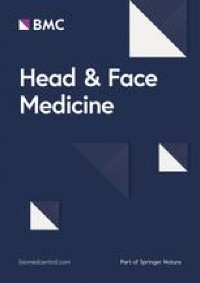|
Medicine by Alexandros G. Sfakianakis,Anapafseos 5 Agios Nikolaos 72100 Crete Greece,00302841026182,00306932607174,alsfakia@gmail.com,
Αρχειοθήκη ιστολογίου
-
►
2023
(272)
- ► Φεβρουαρίου (141)
- ► Ιανουαρίου (131)
-
►
2022
(2066)
- ► Δεκεμβρίου (80)
- ► Σεπτεμβρίου (170)
- ► Φεβρουαρίου (190)
- ► Ιανουαρίου (203)
-
▼
2021
(7399)
- ► Δεκεμβρίου (186)
- ► Σεπτεμβρίου (472)
-
▼
Ιουλίου
(649)
-
▼
Ιουλ 13
(50)
- The Clinical Role of Diffusion-Weighted MRI for De...
- Immunomonitoring of patients treated with CAR-T ce...
- Outcomes of Ttracheostomy in COVID-19 Patients: A ...
- Efficacy of expressions of Arg-1, Hep Par-1, and C...
- Availability of preoperative neutrophil-lymphocyte...
- Intrathecal catheter and port placement for nusine...
- Petrous bone cholesteatoma: our experience of 20 y...
- Tailoring the approach to radioactive iodine treat...
- Scutellarin improves the radiosensitivity of non-s...
- Utility of Non-EPI DWI MRI Imaging in Cholesteatom...
- Bone quality and quantity of the mandibular symphy...
- Essential inpatient otolaryngology: what COVID-19 ...
- Comparison of Conventional and Platelet-Rich Plasm...
- Endoscopic transpterygoid approach to repair later...
- Neuromuscular electrical stimulation for motor rec...
- Effect of an Oral Frailty Measures Program on Comm...
- Radiation-induced swallowing dysfunction in patien...
- The nerve supply to the pectoralis major: An anato...
- A multivariate analysis after preservation rhinopl...
- Clinical relationship between distal interosseous ...
- Prospective clinical trial comparing barbed dermal...
- Safety of Reconstructive Microsurgery in the Elder...
- Outcomes of islanded scrotal raphe flap employment...
- Sutureless venous microanastomosis using thermosen...
- The early years of nuclear medicine: A Retelling
- Surgical Treatment of Sacral Metastatic Tumors
- Validation of European Organization for Research a...
- Safety and Complications of Sedation Anesthesia du...
- Efficacy of Intratympanic Glucocorticoid Steroid A...
- The Story of Separate Yet Connected Cholesteatomas
- Comparison of Modified Child-pugh (MCP), Albumin-b...
- Establishment of Hematopoietic cell transplantatio...
- Psychiatric comorbidities in adult patients with e...
- Plasma level of prostate related-antigen peptide-r...
- Solitary Extramedullary Plasmacytoma of the Oropha...
- Oral Malignant Melanoma
- Study of Hearing Status in COVID-19 Patients: A Mu...
- Lingual-Artery Thromboembolism
- Long-term results of a balloon-assisted endoscopic...
- BCAT1 knockdown-mediated suppression of melanoma c...
- TAFs contributes the function of PTPN2 in colorect...
- Mortalin maintains breast cancer stem cells stemne...
- Monepantel antitumor activity is mediated through ...
- Blood-based risk stratification for pre-malignant ...
- Blinatumomab for HLA loss relapse after haploident...
- Identification and prognostic analysis of the cetu...
- A novel CT-based radiomic nomogram for predicting ...
- MiR-19b-3p and miR-101-3p as potential biomarkers ...
- Methionyl-tRNA synthetase and aminoacyl-tRNA synth...
- NONO phase separation enhances DNA damage repair b...
-
▼
Ιουλ 13
(50)
- ► Φεβρουαρίου (851)
-
►
2020
(2517)
- ► Δεκεμβρίου (792)
- ► Σεπτεμβρίου (21)
- ► Φεβρουαρίου (28)
-
►
2019
(12076)
- ► Δεκεμβρίου (19)
- ► Σεπτεμβρίου (54)
- ► Φεβρουαρίου (4765)
- ► Ιανουαρίου (5155)
-
►
2018
(3144)
- ► Δεκεμβρίου (3144)
Ετικέτες
Πληροφορίες
Τρίτη 13 Ιουλίου 2021
The Clinical Role of Diffusion-Weighted MRI for Detecting Residual Cholesteatoma in Canal Wall up Mastoidectomy
Immunomonitoring of patients treated with CAR-T cells for hematological malignancy: Guidelines from the CARTi group and the Francophone Society of Bone Marrow Transplantation and Cellular Therapy (SFGM-TC)
|
Outcomes of Ttracheostomy in COVID-19 Patients: A Single Centre Experience
|
Efficacy of expressions of Arg-1, Hep Par-1, and CK19 in the diagnosis of the primary hepatocellular carcinoma cubtypes and exclusion of the metastases
|
Availability of preoperative neutrophil-lymphocyte ratio to predict postoperative delirium after head and neck free-flap reconstruction: A retrospective study
|
Intrathecal catheter and port placement for nusinersen infusion in children with spinal muscular atrophy and spinal fusion
|
Petrous bone cholesteatoma: our experience of 20 years and management of two giant cases affecting rhinopharynx
|
Tailoring the approach to radioactive iodine treatment in thyroid cancer
|
Scutellarin improves the radiosensitivity of non-small cell lung cancer cells to iodine-125 seeds via downregulating the AKT/mTOR pathway
|
Utility of Non-EPI DWI MRI Imaging in Cholesteatoma: The Indian Perspective
|
Bone quality and quantity of the mandibular symphyseal region in autogenous bone grafting using cone-beam computed tomography: a cross-sectional study
|
Αναζήτηση αυτού του ιστολογίου
! # Ola via Alexandros G.Sfakianakis on Inoreader
-
Does CBD Oil Lower Blood Pressure? This article was originally published at SundayScaries." Madeline Taylor POSTED ON January 13, 20...
-
Abstract Purpose Clinicians must balance the risks from hypotension with the potential adverse effects of vasopressors. Experts have rec...




